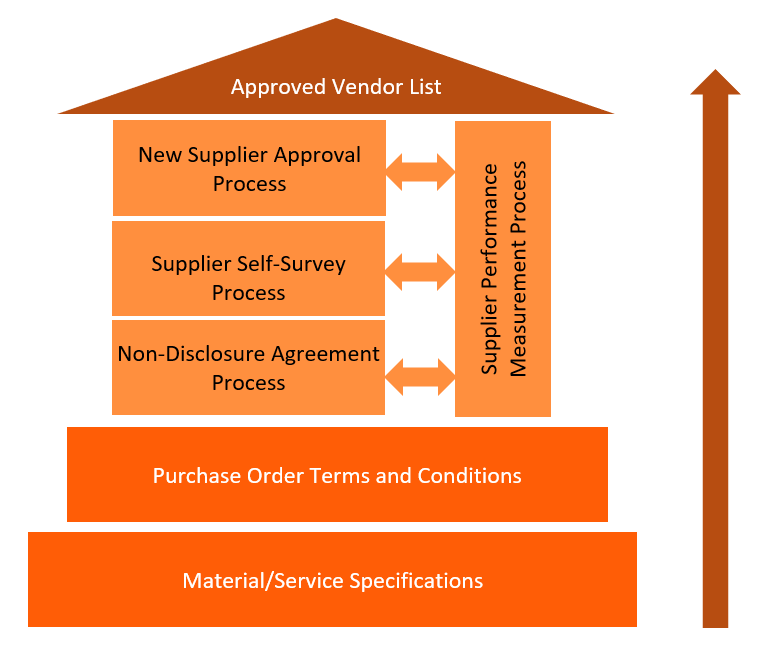|
This is the 5th and final installment in my series concerned with Creating a Supply Chain from Scratch. Through the previous 4 installments, I’ve talked about key foundational elements for any supply chain – regardless of the product. The capstone that brings it all together is Supplier Management, and I will describe my own approach in this final article. Please note, in order to keep this down to a reasonable read, I will speak in general terms. For a detailed explanation of any of these elements, please contact me and I will be happy to expand on specific elements with examples. Supplier Management: The Approved Vendor List Process The Foundation I refer to this entire process as the Approved Vendor List (AVL). The AVL is the output, but the underlying processes are required to identify reliable sources of supply and manage a supply base capable of delivering goods and services at the right price, quality, quantity, and date. The core components of the AVL are required to make the list functional. There are four (4) core processes and two foundational components which underlie this (and other processes), without which the ability to manage suppliers is compromised. Foundation Stones: Material/Service Specifications and Purchase Order Terms and Conditions Material / Service Specification The Bill of Materials (BOM) dictates the materials/service specifications and is part of the design intent. It is the foundation for all supplier management processes, and the last word in what is required in combination with individual material specifications for items in the BOM. To better understand the Material/Service Specifications, please refer to part four of this series. Purchase Order Terms and Conditions Purchase Order Terms and Conditions are critical to any supplier interaction. From the beginning of an interaction, they set the tone of the relationship, define who is responsible for what, establish how quality will be determined and measured, and finally they stipulate how disputes will be resolved. Failure to clearly communicate with the supplier is by far the #1 root cause of poor supplier performance complaints that I have seen over the years. Ultimately, you own responsibility for communication as part of design responsibility, but also as part of your business strategy. It is unwise, and unfair, to rely on suppliers to assume they know what you need. The Four Core Processes Non-Disclosure Agreement In order to ensure an adequate level of due diligence, a non-disclosure agreement should be signed prior to the exchange of any sensitive information with any party. You will want to find out key things related to your supplier’s capabilities, status, and stability. You will also need to share with them key details about your own operations for context. It is best if this agreement is mutual. Please Note - While NDAs are used globally, they are not necessarily valid in some countries! Do your homework to ensure your confidentiality agreements will be recognized in foreign jurisdictions. Supplier Self-Survey In order to have a baseline set of data upon which to evaluate any new supplier, a Supplier Self-Survey should be completed. (Please contact me directly if you would like some examples around how to create a supplier self-survey). I use this survey to reveal summary process capability, financial status, and organizational fit information pertinent to making a reliable determination about a supplier's suitability to provide any product or service. This document should be reviewed in a cross-functional manner with input from Finance, along with any other functional group which is involved in defining the product or service requirement such as Engineering and Customer Service. Don’t overlook Quality personnel, their input is critical. In many situations QA staff will champion this part of the process. Under no circumstances should this survey be used as a replacement for an initial supplier visit/site audit. It is critically important to see your supplier’s operations firsthand, as this always reveals information you would not otherwise know. Most often, it reveals information that is beneficial to everyone involved as it may uncover previously unknown opportunities. A site visit with a completed self-survey in hand, helps to guide and verify the supplier’s suitability. New Supplier Approval Process This is required to validate new sources of supply, and ensure new suppliers can meet the needs of the organization reliably and in a repeatable fashion. This process depends on the Supplier Self-Survey as a data collection framework, as well as the NDA Process as a means to ensure due diligence in sharing sensitive information. You will need to consider how to “try out” this potential new supplier, with a trial, samples, or first-off production. There are various ways this can be done as it depends on many factors, your specific requirements should be considered to determine the best practice here. If the trials go well, the same group that considered the survey details should reconvene to determine if this supplier should be placed on the AVL. Its best to add a supplier on a conditional basis, such as a set period of time or the successful completion of a set volume of production before they are on the list unconditionally. Keep in mind that the AVL will be used by Engineers and Designers as the first consideration of available resources as they do their work, and Sourcing professionals will use this list to validate if their needs can be first met within their existing network (best case) or if work must be done to find a new supplier. From an R&D standpoint, it can be a waste to spend days searching for suppliers if the existing supply base is capable to meet the requirements. As such, this list needs to be maintained as a living document. Business decisions will rely on it, and supplier status can change drastically from approved to disqualified in short order. Want to read more in the Creating a Supply Chain from Scratch Series? Click the links below:
Part 1 - Understanding What a Supply Chain is and When to Start Establishing Your Product's Supply Chain Part 2 - Understanding Chaos and How to Work With It Part 3 - The Planning Hierarchy: Unlocking the Path Forward Part 4 – The Bill of Materials: The Journey is at Least as Important as the Destination Comments are closed.
|


 RSS Feed
RSS Feed